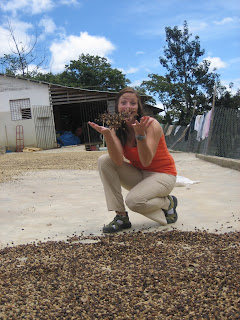
This weekend we spent in the Dominican Republic’s capital, Santo Domingo (SD). The city of SD holds lots of history secondary to it was Bartholomew Columbus, brother of Christopher Columbus, who founded the settlement which is today the oldest European city in the New World.
 We stayed in a hostel called “Bettey’s.” It is a hotel/hostel owned by a Louisianna woman and she has a small art store in the lobby (See Picture Above).
We stayed in a hostel called “Bettey’s.” It is a hotel/hostel owned by a Louisianna woman and she has a small art store in the lobby (See Picture Above). We spent most of our time in the Colonial Zone, which includes many historic landmarks. The Dominican Republic has a very interesting history. Before the Spanish settled in the DR, the land was inhabited by natives. The Spanish invaded and began colonizing the land. The Spainards worked the native people so hard building fortresses, churches and estates that they killed off all native people within 12 years. From then until now the DR has been invaded by pirates, ruled by the french, Liberated from Haitian rule, and controlled by a Dictatorship. From 1930-1961 the country was ruled by dictator Rafeal Leonidas Trujillo. During his dictatorship he believed that people were either for him or against him. He saw All Haitian people to be against him, and during his time as leader executed over 12,000 Haitians. His leadership ended in his execution, leading to the DR finally becoming a democratic country. Above is a picture of the Dominican Flag. The blue is said to stand for Liberty, red for the fire and blood of the independence struggle and the white cross is a symbol of sacrifice. The emblem shows a bible symbolizing a country established in the Catholic faith.
We spent most of our time in the Colonial Zone, which includes many historic landmarks. The Dominican Republic has a very interesting history. Before the Spanish settled in the DR, the land was inhabited by natives. The Spanish invaded and began colonizing the land. The Spainards worked the native people so hard building fortresses, churches and estates that they killed off all native people within 12 years. From then until now the DR has been invaded by pirates, ruled by the french, Liberated from Haitian rule, and controlled by a Dictatorship. From 1930-1961 the country was ruled by dictator Rafeal Leonidas Trujillo. During his dictatorship he believed that people were either for him or against him. He saw All Haitian people to be against him, and during his time as leader executed over 12,000 Haitians. His leadership ended in his execution, leading to the DR finally becoming a democratic country. Above is a picture of the Dominican Flag. The blue is said to stand for Liberty, red for the fire and blood of the independence struggle and the white cross is a symbol of sacrifice. The emblem shows a bible symbolizing a country established in the Catholic faith.
We also visited the Catedral Santa Maria La Meno (Above), which is the first Catholic cathedral in America. The tour guide said “That 85% of the Dominican Republic is Catholic and the other 15% are alcoholics!” (That tour guide had me figured out didn't she!)
We also visited an amber and larimar museum. We saw insects that were preserved in amber that were over 50 million years old. Larimar is that rare blue stone found only in the DR and is often set in silver. They say that amber is a color of Luck while larimar (blue) is a color of love. So if you want a piece of luck you buy amber jewelry and if you want to find love you buy larimar jewelry. AND………..if you want to get “lucky with love” you buy a ring that is interchangeable! hehhe















































